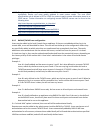
122
9.2 PAM (Pluggable Authentication Modules)
The Console Server supports RADIUS, TACACS+ and LDAP for two-factor authentication via PAM
(Pluggable Authentication Modules). PAM is a flexible mechanism for authenticating Users. Nowadays, a
number of new ways of authenticating users have become popular. The challenge is that each time a
new authentication scheme is developed, it requires all the necessary programs (login, ftpd, etc.) to be
rewritten to support it.
PAM provides a way to develop programs that are independent of authentication schemes. These
programs need "authentication modules" to be attached to them at run-time in order to work. Which
authentication module is to be attached is dependent upon the local system setup and is at the
discretion of the local Administrator.
The Console Server family supports PAM to which we have added the following modules for remote
authentication:
RADIUS - pam_radius_auth (http://www.freeradius.org/pam_radius_auth/
)
TACACS+ - pam_tacplus (http://echelon.pl/pubs/pam_tacplus.html
)
LDAP - pam_ldap (http://www.padl.com/OSS/pam_ldap.html
)
Further modules can be added as required.
Changes may be made to files in /etc/config/pam.d/ which will persist, even if the authentication
configurator is run.
Users added on demand:
When a user attempts to log in, but does not already have an account on the Console Server, a
new user account will be created. This account will not have any rights, and no password set.
They will not appear in the configuration tools.
Automatically added accounts will not be able to log in if the remote servers are unavailable.
RADIUS users are currently assumed to have access to all resources, so will only be authorized to
log in to the Console Server. RADIUS users will be authorized each time they access a new
resource.
Admin rights granted over AAA:
Users may be granted Administrator rights via networked AAA. For TACACS, a priv-lvl of 12 of
above indicates an administrator. For RADIUS, administrators are indicated via the Framed Filter
ID. (See the example configuration files below, for example.)
Authorization via TACACS for both serial ports and host access:
Permission to access resources may be granted via TACACS by indicating an appliance and a port
or networked host the user may access. (See the example configuration files below, for
example.)
TACACS Example:
user = tim {
service = raccess {
priv-lvl = 11
port1 = xxxxx/port02


















